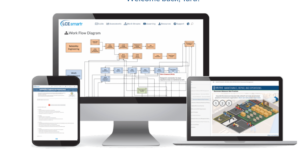As NAVSEA’s Deputy Commander for Surface Warfare, SEA 21 is the dedicated life cycle management organization for the Navy’s in-service surface ships. It is responsible for managing critical modernization, maintenance, training and inactivation programs. SEA 21 serves as the primary technical interface for surface ships, ensuring they are modernized with the latest technologies and remain mission relevant throughout each ship’s service life.
Established in 2004, the Navy Modernization Process (NMP) provides a disciplined process to deliver operational and technical modifications to the naval surface fleet in an operationally effective and cost-efficient way. The NMP defines a standard methodology to plan, budget, engineer, and install timely, effective, and affordable shipboard improvements while maintaining configuration management and supportability. This process is web enabled via the Navy Data Environment, a secure database and user interface that supports the NMP for effective and efficient process management.
As manager for the NMP and In-Service Engineering Support Agent for all NAVSEA21 hull, mechanical and electrical (HM&E) equipment, Naval Surface Warfare Center Philadelphia Division (NSWCPD) relies on contractor support to meet various responsibilities. A major part of the NMP is the Integrated Logistics Support (ILS) Certification, which ensures that significant issues of configuration support are addressed with an Integrated Logistic Support Package. These packages include:
- ILS Certification
- Approved drawings
- Allowance parts list (APL)
- XSFT software files
- CDMD-OA File
- DD-1149 paperwork for ILS deliverables
- Technical manuals
- Planned maintenance (PMs)
- Onboard Repair Parts (OBRPs)
- Special tools
- Gauge calibration
- Training
LCE started processing ILS certifications and loading configuration overhaul planning data for NSWCPD Alteration Installation Teams (AITs) in 2003. Early support included APLs, technical manuals and planned maintenance for alterations being installed on specific ship classes (FFGs, CGs, DDGs and MCMs/MSOs) during Windows of Opportunities (WOOs) and Continuous Maintenance Availabilities (CMAVs). The only timeline requirement was to have the alteration logistically certified prior to the AIT team working the install. Over time the scope of LCE’s support expanded to Chief of Naval Operations (CNO) availabilities which included Selected Restricted Availabilities (SRAs), Extended Selected Restricted Availabilities (ESRAs), Drydock Selected Restricted Availabilities (DSRAs) and Extended Drydock Selected Restricted Availabilities (EDSRAs).
This expanded scope was accompanied by changes in timeline requirements. The timelines to have ILS certifications completed and certified by the Ships Program Mangers (SPMs) changed to A-120 (four months prior to the ship’s availability.) LCE expanded its team to meet these new scope and timeline requirements. The team began supporting all HM&E alterations (AIT and non-AIT) being installed during CNO availabilities, and attending and presenting at the Integrated Logistics Management Team meetings. Each alteration being installed needed an ILS kit consisting of two binders and CD-ROMS that included:
- APLs for the equipment
- PMS (Maintenance Index Page and associated Maintenance Requirement Cards)
- Technical manuals
- Ships Installation Drawings (SIDs)
- Configuration Overhaul Planning (COP) Files and AIT verification reports
In 2016 the timeline for completing ILS certifications changed again, to A-180 (six months prior to the availability.) This presented a unique problem because the timeline for SIDs was at A-240, giving us approximately 60 days to complete all ILS certifications.
With the LCE team’s attention to detail and ability to complete all ILS certifications on time, NSWCPD became the lead for all HM&E ILS certifications on all classes of ships. LCE’s support role has continued to expand. The team also creates Availability Base Line Reports (ABRs), Maintenance Baseline Reports (MBRs), and Habitability Baseline Reports (HBRs) for every CNO availability, CMAV and WOO. These documents help the Configuration Data Managers, Regional Maintenance Centers, Onsight Logistics’ Representatives, Type Commanders and SEA21. The ABRs, MBRs and HBRs provide a snapshot of the configuration the ships should expect to receive during their availabilities.
The LCE team also works with the ISEAs, TYCOMs, and SEA21 to ensure alterations are scheduled in the Navy Data Environment (NDE) in a timely manner so the ILS certs can be created and completed within the timeline set forth by the Navy Modernization Process Management and Operations Manual.

To learn more about LCE’s ongoing naval support,
visit the Integrated Logistics Support web page.
















